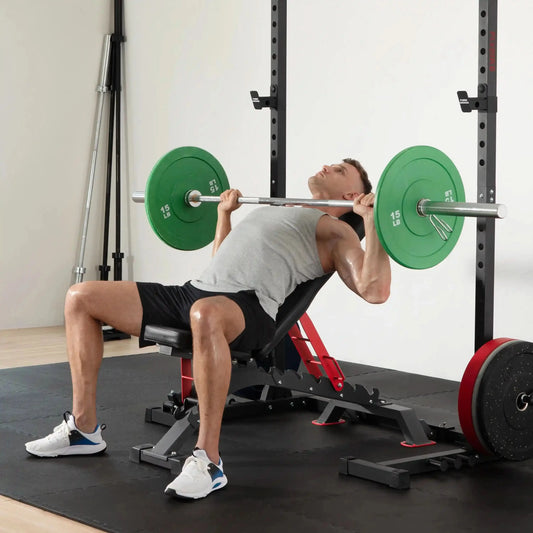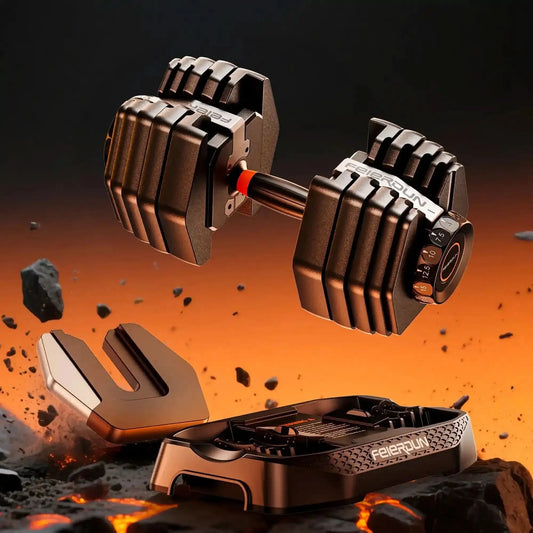Walk into any gym, and you'll hear people talking about their bench press weights.
"Two weight plates!" "Three weight plates!" But if you ask them how much the barbell is, they might pause for a moment.
Most weightlifters don't think about this question, but the barbell itself adds weight to each bench press.
The weight of the barbell can change your total load, strength data, and even your risk of injury. If you're serious about tracking progress, the weight of your barbell should be one of the first things you need to know. In this article, we'll discuss the different weights of bench press barbells and how to find out "how heavy is your bench press bar?".
What is a Bench Press Barbell? What is its purpose?
Essentially, a bench press barbell is a steel bar used to hold weight plates in place. But it's far from an ordinary piece of equipment.
The barbell is central to any upper-body strength training. It allows you to lift heavy objects safely and evenly.
Its design purpose is as follows:
- To distribute the load evenly between both arms, preventing excessive force on one side.
- Provides a secure grip with its knurled texture.
- Balances rigidity and flexibility for smooth movement even under heavy weights.
- Compatible with most gym standard bench press benches, squat racks, and clamps.
How to Check the Weight of Your Bench Press Barbell?
Not all bench press barbells are the same weight. They vary depending on brand, design, and intended use. The standard weight for barbells in IPF powerlifting competitions is 20kg, while there's no fixed standard for bench press bars used in home training and gyms; they are typically available in 20kg, 15kg, 10kg, 12kg, etc. We can purchase or choose the appropriate bench press bar based on our training needs.
But how do you know the weight of your bench press bar?
-
Use the weight markings: Many brands use color-coded markings on both ends of the bench press bar to indicate the weight (red for 25kg, blue for 20kg, yellow for 15kg, and green for 10kg), while some simply state the weight directly.
-
Use product information: The weight of the bench press bar will be indicated in the product manual and on the product page.
-
Obtain weight from the seller: You can directly contact the seller and send them your bench press bar to get its weight.
-
Obtain weight by weighing: You can directly place the barbell on an electronic scale to weigh it, but this may introduce errors. You can hold the bench press bar with both hands, stand on the scale, get the first weight, then put the bar down and weigh it again to get the second weight. The weight of the bench press bar = first weight - second weight.
How to Calculate Bench Press Weight?
Many people directly calculate the weight of the weight plates as their bench press weight.
A very small number of people use: Barbell weight + (total weight of weight plates on both sides) = total bench press weight. Think this is correct? This is incorrect. You need to check if your barbell has clips on both sides. If there are clips, you need to add the weight of the clips, which are usually 2.5kg each.
Therefore, the correct calculation method is:
Total bench press weight = Barbell weight + Weight of the weight plates on both sides + Weight of the Collars on both sides
For example: Now you are doing bench presses with a
FED Fitness 20kg barbell, with 50kg weight plates on each side and a 2.5kg buckle on each side, then:
Total bench press weight = 20 kg + (50 kg × 2) + (2.5 kg × 2)
Conclusion
Every bench press is crucial, and every pound is equally important. You have learned how to weigh your bench press barbell and how to correctly calculate your bench press weight. By tracking your barbell weight, recording your total weight, and maintaining regular training, you will be able to lift even heavier weights.
Questions About Bench Press
Do all bench press bars weigh 45 lbs?
No. Forty-five pounds is the gym standard, but not the rule. Women’s Olympic bars, training bars, and Smith bars often range from 15 to 35 lbs.
Should I count the bar weight in my total?
Always. Leaving it out gives false numbers and skews your 1RM calculations. The bar is part of the lift.
How much does a Smith machine bar weigh?
Usually 15–25 lbs, depending on the brand and counterbalance system. If you’re unsure, check the manufacturer’s specs or weigh it.












